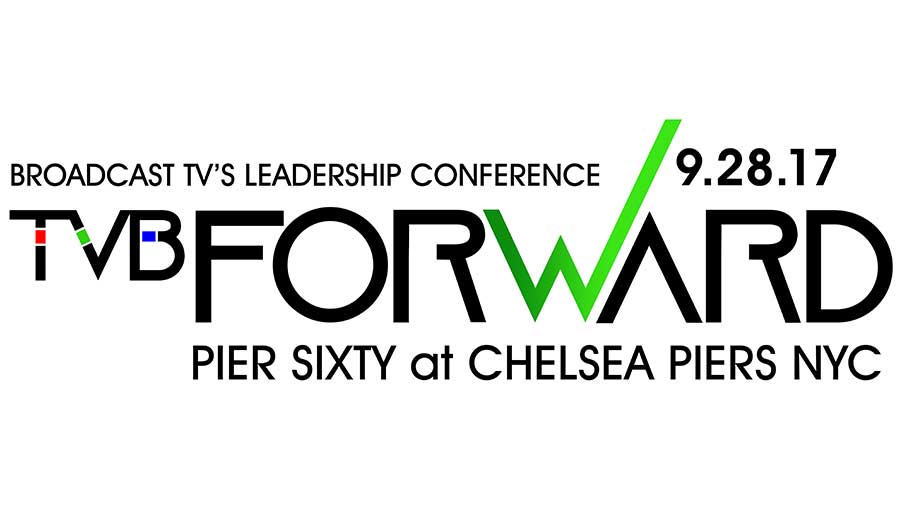TVB Conference All About An Industry Looking Forward

The Television Bureau of Advertising’s annual Forward conference, held each year in the early fall, is consistently built around one core theme: advancing the broadcast industry.
And as the organization preps for its Sept. 28 confab in New York, that notion is particularly apt, as broadcasters are increasingly experimenting with — and starting to implement — innovations meant to keep the local TV business successful.
For instance, automated and advanced advertising has the potential to reinvigorate local TV’s relationship with national advertisers, primarily by easing the cumbersome transactional process which, in recent years, has kept them at bay, said Steve Lanzano, the TVB’s president and CEO.
After years of grappling with how to maximize social media — first to garner audiences and more recently how to monetize it — broadcasters are starting to see payoffs courtesy of new digital strategies and tracking capabilities, he said.
The science of audience measurement is at an inflection point, as broadcasters’ demands rise with the advent of electronic measurement tools and data — and providers, from mainstay Nielsen to newer players such as comScore, roll out new processes to meet them.
After last year’s nontraditional presidential election — and its equally nontraditional political ad spend — broadcasters are taking hard looks at forecasts for 2018 midterm election spending, and what they could mean for local TV’s bottom line.
And while next-generation broadcasting and ATSC 3.0 are still three or four years off, the new standard offers the potential for sweeping change, from a multifold increase in broadcasters’ delivery capacity to interactive opportunities. And the technology, and its breadth of potential upsides, is at the core of any exploration of TV’s future.
Tackling Tough Issues
“A lot of what we do at the conference is hit issues head-on,” Lanzano said. “If we don’t do that, that’s when the industry goes downhill.”
The agenda for this year’s one-day Forward conference has been purposely crafted to spur “vibrant” conversations around these issues, Lanzano said, along with how the industry can best advance amidst increased challenges and competition.
Wells Fargo analyst Marci Ryvicker (one of the conference’s top draws, Lanzano said) will offer her annual look at the where she believes the industry is, where it’s going and the larger economic and social factors that influence its well-being.
This conference has also upped the focus on digital opportunities, Lanzano said. Catherine Badalamente, Graham Media’s VP of digital media, will moderate a panel focused on the monetization of social and mobile platforms, as well as smart TV.
Measurement is top of mind for many broadcasters, and the conference will include three presentations on the subject. Jeff Wender, Nielsen’s managing director of local media, will explore local audience measurement, as will comScore president Bill Livek in a separate presentation.
Automated and advanced advertising, another area of particular interest, will be addressed in a panel discussion led by Rick Ducey, BIA/Kelsey’s managing director.
Lanzano said automated advertising — i.e. easing the transaction process — is necessary to expand advertisers’ attraction to the medium.
“It’s the only way to bring national advertising back to local,” he said. “They want our inventory. We need to make it easier for them to access it.”
The state of the auto industry and political projections, two key ad categories, will be the focus of presentations. So will a video discussion with Byron Sharp, the Australian professor whose work on growing brands through advertising could help fuel their return to local TV, Lanzano said.
Jordon Wertlieb, president of Hearst Television, will be formally honored as B&C’s 2017 Broadcaster of the Year for his efforts to strategically grow the station group’s offerings and reach.
In keeping with the conference’s overarching theme, WideOrbit, which builds broadcasters’ publishing platforms, has also ramped up efforts to incorporate younger broadcasters’ participation in the day. That includes sponsoring the inaugural TVB Next awards, created to honor “tomorrow’s media leaders.”
“It’s [about] getting that next generation of talent and leaders and getting them more involved — and showing them that it’s still a vibrant industry, and that we see a future in it,” Lanzano said. “We are talking about how we’re going to move the business forward.”
The smarter way to stay on top of broadcasting and cable industry. Sign up below
